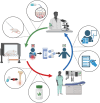New paradigms in pain management after skeletal trauma: Orthopaedic Trauma Association's 2023 Basic Science Focus Forum Symposium
- PMID: 40170872
- PMCID: PMC11956757
- DOI: 10.1097/OI9.0000000000000352
New paradigms in pain management after skeletal trauma: Orthopaedic Trauma Association's 2023 Basic Science Focus Forum Symposium
Abstract
Traumatic injuries are associated with significant acute pain and subsequent high risk of the development of chronic pain. However, addressing pain after skeletal trauma presents a complex challenge to achieve effective pain relief that minimizes risk of addiction and does not interfere with functional recovery. The Orthopaedic Trauma Association's 2023 Basic Science Focus Forum aimed to bridge the gap between basic science and clinical outcomes with an educational symposium on pain management designed to foster collaboration and provide practical strategies from the frontiers of pain research. Owing to the subjective and multifaceted nature of pain, the development of effective preclinical and clinical pain assessment measures is the first step to making impactful progress in studying pain. Preclinical models prove a valuable tool for studying the molecular mechanisms associated with pain following orthopaedic trauma. These models also allow study of the efficacy of novel pain management techniques, such as testing novel analgesics. Translating novel analgesics and pain management strategies to the clinic requires that we have accurate methods to describe pain to determine whether new approaches are meaningful. It is also necessary to recognize the patient's role and the importance of patient education in the prevention of pain medication misuse, particularly in light of the current national opioid crisis. Overall, collaboration with orthopaedic surgeons in the application of these strategies in a clinical setting is vital for addressing the downfalls of current pain management efforts and providing patients with safe and effective improvements in pain relief after skeletal trauma.
Keywords: fracture healing; orthopaedic trauma; pain management; patient-reported outcomes; preclinical models.
Copyright © 2025 The Authors. Published by Wolters Kluwer Health, Inc. on behalf of the Orthopaedic Trauma Association.
Conflict of interest statement
J. V. Hartman Budnik, BS—No conflict. T. F. Higgins, MD—Orthopaedic Trauma Association: Board or committee member. A.-M. Malfait, MD, PhD—No conflict. J. Weinrich, PhD—No conflict. A. Basbaum, PhD—No conflict. J. Hsu, MD—No conflict. S. Morshed, MD, PhD—Orthopaedic Trauma Association: Board or committee member. C. S. Bahney, PhD—Orthopaedic Trauma Association: Board or committee member. Source of funding: Nil.
Figures

Similar articles
-
Preclinical models of orthopaedic trauma: Orthopaedic Research Society (ORS) and Orthopaedic Trauma Association (OTA) symposium 2022.OTA Int. 2024 Mar 11;7(2 Suppl):e303. doi: 10.1097/OI9.0000000000000303. eCollection 2024 Mar. OTA Int. 2024. PMID: 38487400 Free PMC article.
-
The effect of the orthopaedic trauma association's (OTA) pain management guidelines on opioid prescriptions, pain control, and refills in outpatient orthopaedic trauma surgery.Eur J Orthop Surg Traumatol. 2022 Feb;32(2):237-242. doi: 10.1007/s00590-021-02951-z. Epub 2021 Mar 30. Eur J Orthop Surg Traumatol. 2022. PMID: 33783629
-
The expanding role of additive manufacturing in orthopaedic traumatology.OTA Int. 2025 Apr 1;8(2 Suppl):e388. doi: 10.1097/OI9.0000000000000388. eCollection 2025 Apr. OTA Int. 2025. PMID: 40170869 Free PMC article.
-
Leading the Way to Solutions to the Opioid Epidemic: AOA Critical Issues.J Bone Joint Surg Am. 2017 Nov 1;99(21):e113. doi: 10.2106/JBJS.17.00066. J Bone Joint Surg Am. 2017. PMID: 29088045 Review.
-
Confronting the Opioid Crisis: Practical Pain Management and Strategies: AOA 2018 Critical Issues Symposium.J Bone Joint Surg Am. 2019 Dec 4;101(23):e126. doi: 10.2106/JBJS.19.00285. J Bone Joint Surg Am. 2019. PMID: 31800430 Review.
References
-
- Wheatley BM, Nappo KE, Christensen DL, et al. . Effect of NSAIDs on bone healing rates: a meta-analysis. J Am Acad Orthop Surg. 2019;27:e330–e336. - PubMed
-
- Simon AM, O'Connor JP. Dose and time-dependent effects of cyclooxygenase-2 inhibition on fracture-healing. J Bone Joint Surg Am. 2007;89:500–511. - PubMed
-
- Giannoudis PV, MacDonald DA, Matthews SJ, et al. . Nonunion of the femoral diaphysis. The influence of reaming and non-steroidal anti-inflammatory drugs. J Bone Joint Surg Br. 2000;82:655–658. - PubMed
Grants and funding
LinkOut - more resources
Full Text Sources
Miscellaneous
